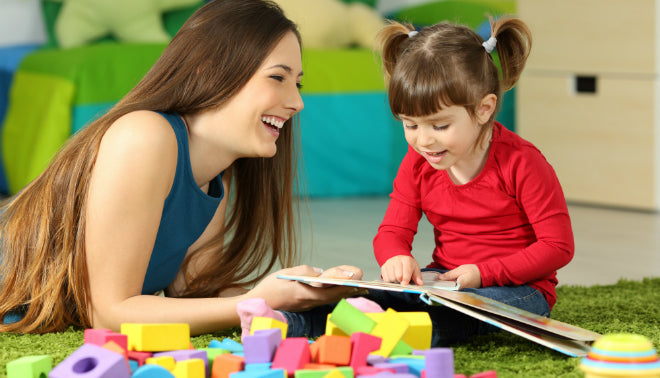" How children learn through play "
The world is wonderfully colorful and shines in an almost indescribable variety of colors. It takes a while before people are able to see and recognize all these wonderful colors. In order to impart this knowledge to the youngest children, they need to approach the subject in a playful way. When it comes to learning colors and the most important shapes, there are various options. Today we'll give you some great ideas on how you can use educational games to teach your child their first shapes and colors.
Just shades - The environment slowly fills up with its variety of colors
A newborn baby does not yet perceive color tones. This takes a few weeks. At first, the world appears in different shades. An infant can already distinguish quite well between light and dark. But what is red or blue is still written in the stars. Vision is one of the last senses to develop. While an infant in the womb can already perceive the voices and sounds of the outside world, the abilities of the eyes are not yet required in the rather dark environment. Vision therefore develops later.
When should a child know colors?
It is quite normal for parents to be concerned about the age at which a child should know the different colors. Experience shows that most children have mastered the most important colors by the age of four and are able to distinguish and name colors. So you can be reassured if the 2-year-old next door can already tell the difference between blue and red, but your slightly older daughter is not yet interested.

Children learn the correct assignment of colors by the age of four
The fact is, however, that knowledge of certain shapes and colors serves as the basis for many other areas of learning.
Educational games: Learning shapes and colors with simple means
Children learn unconsciously every day. Everything that a small child encounters during the course of a day and is still new is examined with great curiosity. As a parent, you can support your child by using educational games, which don't have to be complicated or time-consuming. After all, toddlers naturally cannot concentrate for as long as older children will later be able to. When learning shapes and colors, you can also make use of the diversity of nature.
Sorting - the first learning games for the very youngest children
Sorting individual objects is one of the very youngest children's favorite activities. With a little guidance and supervision, they can learn what color the building block is and which shape fits into which opening. So take some time now and then to spend time with your little angel. Always speak clearly and not in incomprehensible baby language when you want to learn shapes and colors:
- "That's a red stone!"
- "The push-along car is blue!"
- "The rattle is green!"

Learning shapes and colors begins in the baby phase
Your little sunshine won't be able to do much with it yet, but it will enable your little one to get to grips with different colors from the very beginning.
Memory - make and vary the classic yourself
Who doesn't know the famous memory game? Some children steal the show from us grown-ups when they intently uncover one pair after the next. The first learning games of this kind deal with simple patterns and even color tones. You can make such a simple memory game yourself in just a few simple steps.
All you need is- Cardboard
- scissors
- Nuscheli in 6 different colors

- First of all, cut 12 squares of the same size from the cardboard. Now you need to design 6 pairs, which are then also cut out of the remaining cardboard. To learn a few figures in addition to the colors, cut out the patterns for the pairs in the appropriate shape:
- Circle
- square
- square
- triangle
- Star
- Cross
- You now have two options. You can create these little figures with finger paints or use the Nuscheli fabrics and stick them onto the cardboard shapes. Either way, you will end up holding a pair of the same color and shape in your hand.
- Now stick the cardboard shapes onto the blank cards. You then have two levels of difficulty to choose from. For the little ones, it is certainly more interesting to have the cards face up in front of them first and then sort them by color.
Older children, on the other hand, naturally play the classic memory game. In other words, spread the cards face down on the table and then find the pairs.
Tip: You can design a memory game like this in many different ways and adapt it to the abilities of the players over time.
Natural materials: Great learning games with products from nature
Feeling, touching, learning - probably one of the most wonderful combinations to quench a toddler's thirst for knowledge. We must never forget that toddlers in particular try out and gain experience through their senses.


Lace up your shoes, take a small, pretty children's bag with you on a walk and explore nature.
There are lots of little games to accompany this outing. Depending on age and enthusiasm, you can always vary the following suggestions and expand or modify them as you see fit.
The aim is always to collect as many things as possible, which are previously listed under a generic term:
"What is all green?"
On a leisurely walk through the woods and fields, you and your children are likely to come across lots of things that look green.

Nature offers many opportunities to teach children about shapes and colors
"What is everything round?"
Now it's time to search eagerly for round materials. Here, too, nature has many little treasures in store for the children's pockets.
Along the way, the little ones not only get to know the shape and color of certain objects better, but also learn many interesting things from nature. Last but not least, all these little treasures end up being either the perfect craft material or an addition to the little treasure chest in the children's room.
Whether outdoors or indoors. When toddlers are learning shapes and colors, have everyone sit in a circle. Lay out a few cloths in the basic colors beforehand. Now hold one up and ask for the color.
The child who answers correctly can keep the cloth. Alternatively, pick up a ball and give it to the person sitting next to you.










